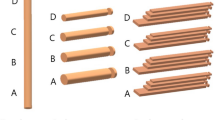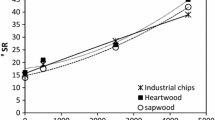Abstract
The Tasmanian sawmilling industry has traditionally been heavily focused on the processing of mature eucalypt timbers. However, the available log supply has contained an increasingly high proportion of younger, smaller regrowth logs. In response to this change, the Tasmanian sawmilling industry carried out an experimental program aimed at determining a means of processing regrowth Eucalyptus obliqua into high quality sawn and dried timber similar to that available from mature logs. Initial investigations revealed that application of conventional processing techniques to the production of dried machined tangentially sawn (“backsawn”) 25 mm and 19 mm thick boards did not produce commercially viable results. Two possible techniques for reducing drying degrade were investigated: storing boards for some time prior to drying and periods of zero airflow applied intermittently during drying. Neither technique proved effective. Quartersawn timber was found to undergo less surface checking and endsplit than did backsawn. Thinner boards showed no decrease in drying degrade when compared to thicker boards.
Zusammenfassung
Die tasmanische Sägeindustrie ist traditionell überwiegend auf die Verarbeitung von erwachsenem Eucalyptusholz ausgerichtet. Allerdings steigt beim verfügbaren Rohholz der Anteil an jüngeren und kleineren Stämmen aus Nachwuchs zunehmend an. Als Reaktion auf diesen Wandel hat die tasmanische Sägeindustrie ein Versuchsprogramm durchgeführt, um Bearbeitungsverfahren zu entwickeln, mit denen Nachwuchs-Eucalyptus obliqua zu qualitativ hochwertigem getrockneten Schnittholz, ähnlich dem von erwachsenem Holz, verarbeitet werden kann. In Vorversuchen stellte sich heraus, dass die konventionelle Herstellung getrockneter 25 mm und 19 mm dicker Bretter mit vorwiegend liegenden Jahrringen (,,backsawn“) zu keinen kommerziell befriedigenden Ergebnissen führte. Zwei mögliche Verfahren wurden untersucht, um eine Qualitätsminderung durch Trocknungsschäden zu reduzieren: Vortrocknung, d.h. Lagerung der Bretter einige Zeit vor der technischen Trocknung sowie intermittierende Phasen ohne Luftzirkulation während der Trocknung. Keines der beiden Verfahren erwies sich als wirksam. Schnittholz mit vorwiegend stehenden Jahrringen (,,quartersawn“) erwies sich weniger anfällig für Oberflächenrisse und Risse an den Brettenden als tangential eingeschnittenes Holz. Dünnere Bretter wiesen im Vergleich zu dickeren Brettern nicht weniger Trocknungsschäden auf.
Similar content being viewed by others
References
Booker JD (1995) Acoustic emission related to strain energy during drying of Eucalyptus regnans boards. Wood Sci Technol 29:145–156
Forestry Tasmania (2002) Sustainable High Quality Eucalypt Sawlog Supply from Tasmanian State forest – Review No 2, Planning Branch, Forestry Tasmania
Keey RB, Langrish T, Walker JCF (1999) Kiln Drying of Lumber (Springer series in wood science). Springer, New York Berlin Heidelberg
Oliver AR (1991) A model of the behaviour of wood as it dries (with special reference to Eucalypt materials). Research Report CM91-1, Civil and Mechanical Engineering Department, University of Tasmania
Author information
Authors and Affiliations
Corresponding author
Rights and permissions
About this article
Cite this article
Innes, T., Bennett, P. & Lee, M. Drying of tangentially-sawn regrowth Tasmanian Eucalyptus obliqua . Holz Roh Werkst 63, 365–371 (2005). https://doi.org/10.1007/s00107-005-0031-6
Published:
Issue Date:
DOI: https://doi.org/10.1007/s00107-005-0031-6




